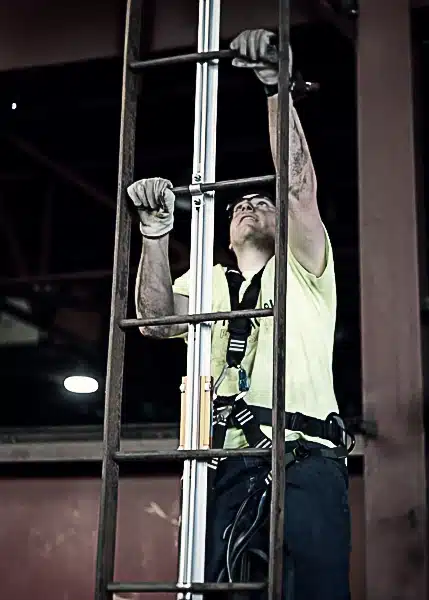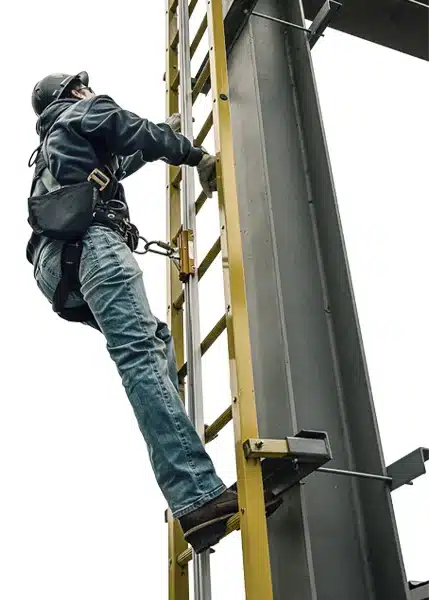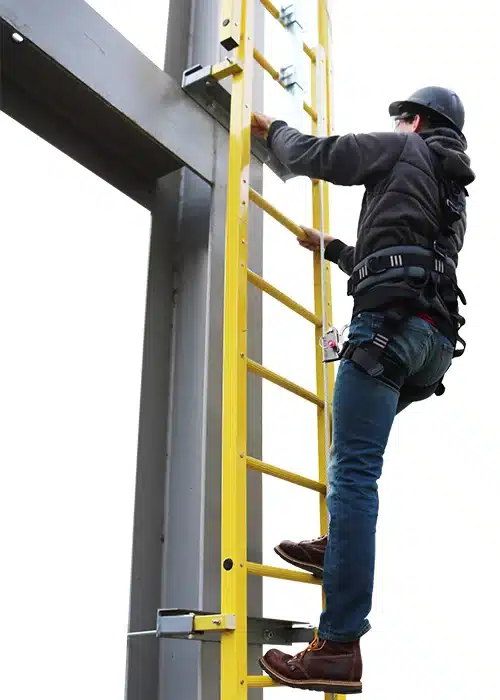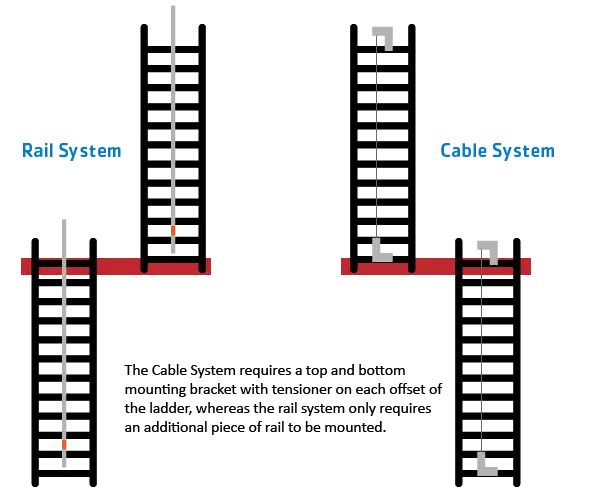Your cart is currently empty!
Ladder Safety Systems: Rail vs. Cable – Which One Should You Choose?

In the world of General Industry, where our top priority is ensuring the safety of both our hardworking employees and the valuable equipment they use, you can count on FrenchCreek Fall Safety – a renowned manufacturer specializing in fall protection solutions. At FrenchCreek, we take ladder safety very seriously, and we’re proud to offer not one, but two ladder safety systems that align with the latest safety requirements set by OSHA.
This article aims to go the extra mile by providing an in-depth exploration of our two exceptional ladder safety systems: the rigid rail and cable ladder safety systems. Our goal is to equip you with all the knowledge and insights you need to make a well-informed decision for your workplace. So, let’s take a deep dive into the world of Rail vs. Cable Ladder Safety Systems, where safety standards are not just met but exceeded to ensure the well-being of your workforce and the protection of your valuable equipment.
Rail Ladder Safety Systems:

FrenchCreek takes immense pride in providing rail ladder safety systems that have become the go-to choice for safely accessing elevated areas across a wide spectrum of industrial settings. These versatile systems are trusted and relied upon in diverse industrial environments.
The core of these systems lies in their design, featuring a rigid rail or track carefully secured to a fixed ladder. This rail serves as a lifeline for workers, ensuring their safety during tasks that require them to ascend to elevated positions. What makes this system especially safe is the fall protection trolley that workers securely attach themselves to. This trolley isn’t just an ordinary piece of equipment; it’s an ingenious safety mechanism. In the event of an unexpected fall, this trolley immediately springs into action, swiftly locking onto the rail with precision, thus arresting the fall and preventing any further descent.
The combination of the fixed rail, fall protection trolley, and quick response in case of a fall ensures that workers have the freedom to climb the ladder knowing that their safety is uncompromised.
Advantages of the Rail Ladder Safety System
- Enhanced Stability: Rail ladder systems are fixed solidly to the ladder by mounting brackets offering an unparalleled level of stability, significantly reducing the risk of accidents. This becomes particularly crucial in outdoor settings where workers might need to ascend a fixed ladder during conditions like high winds or other challenging environmental scenarios.
- Easy Installation: With only mounting brackets connecting to the ladder, the rail system is relatively easy to install.
- Working Inside Tanks: In many tank applications, workers often need to climb a fixed ladder situated inside the tank. Usually, when they’re climbing out of the tank, it involves accessing a hatch. Here’s where the rail system shines – it can be easily customized with additional add-ons to ensure a safe transition out of the tank hatch.
- Potable Water: If your work environment contains a corrosive atmosphere, such as potable water, FrenchCreek Fall Safety recommends opting for a stainless steel rail system due to its resistance to corrosion.
- Multiple Standoffs: Our rail system is a cost-effective choice for applications involving ladders that need multiple standoffs. It’s as simple as adding an extra piece of rail for each ladder section, and you can keep on climbing with the same trolley. No need for extra gear or complications!
Disadvantages of the Rail Ladder Safety System
- Initial Cost: While cost-effective in the long run, the initial investment in our high-quality rail systems can be slightly higher than that of the cable system.
Cable Ladder Safety Systems

Conversely, FrenchCreek Fall Safety’s cable ladder safety systems utilize a flexible cable or lifeline that runs along the entire length of the ladder. Workers attach themselves to this cable using a harness and cable grab, providing fall protection while allowing greater mobility. The cable is affixed to the top and bottom of the ladder via two brackets, and a tensioner is employed to eliminate any slack in the lifeline.
The installation of the cable grab at the fixed ladder’s base is a straightforward process, and it diligently trails the worker’s ascent. In the event of an unforeseen fall, the cable grab will promptly engage, securing itself to the lifeline, while the shock-absorbing pack activates, effectively mitigating the impact of the fall arrest forces on the worker.
The vertical cable system stands as a well-established and time-honored solution in the realm of fall protection for fixed ladders. Its reputation is built upon years of reliable performance and safety, making it a trusted choice for safeguarding workers in various industries.
Advantages of the Vertical Cable Ladder Safety System:
- Increased Mobility: Our cable systems provide unparalleled flexibility, granting workers the freedom to maneuver effortlessly along the ladder. The inherent simplicity of cable systems, as opposed to rails, offers workers greater liberty of movement, especially when working in the middle of a fixed ladder.
- Versatility: They are suitable for various ladder configurations and lengths. Always verify the ladder’s strength capacity before installing any system.
- Lower Initial Costs: FrenchCreek Fall Safety’s cable systems typically come with a more budget-friendly initial cost, especially when dealing with single high-length systems that don’t require multiple standoffs.
- Ease of Installation: Since the cable system only necessitates two mounting brackets at the ladder’s top and bottom, along with a few cable guides, it can be argued that it’s easier to install compared to the rigid rail system, which demands several rung clamps at specific intervals.
Disadvantages of the Vertical Cable Ladder Safety System:
- Lifeline Wear: Over time, the lifeline may endure more wear and tear compared to a rail system, potentially requiring replacement. It’s important to conduct regular inspections of your system to ensure its ongoing safety and performance.
- Multiple Standoffs: When you’re setting up a vertical cable system, you need a top bracket and a bottom bracket with a tensioner for each section. This can add up in terms of cost, especially when you’re installing the system on a ladder with multiple standoffs. In contrast, with rail systems, each section can be individually attached, offering a potentially more cost-effective solution.

- Potable Water: While the cable system is offered in stainless steel, which is suitable for sea salt and maritime environments, it is not recommended for use in potable water settings.
Rail vs. Cable Ladder Safety Systems: Which Is the Right Choice?
Choosing between FrenchCreek Fall Safety’s rail and cable ladder safety systems depends on your workplace’s specific requirements and tasks. Considering budgetary factors, both systems have their advantages and disadvantages. The rail system proves to be cost-efficient when dealing with ladders equipped with multiple standoffs. On the other hand, the cable system offers greater cost efficiency for long ladders with single spans. However, when it comes to applications in corrosive environments and potable water settings, FrenchCreek always recommends opting for the stainless steel version of the rigid rail system.
When it comes to ladder safety, FrenchCreek Fall Safety’s rail and cable ladder safety systems are highly capable options. Each system has its unique advantages and disadvantages, making them suitable for different scenarios. By understanding the distinctions between them, you can select the one that best aligns with your safety requirements. Prioritizing the well-being of your workers and the integrity of your equipment is a step in the right direction for a safer and more efficient workplace.
FAQs
Q: At what height do fixed ladders require a fall protection system?
A: OSHA requires employers to have ladder safety or personal fall arrest systems for fixed ladders that extend more than 24 feet.
Q: Can employers use fixed ladders with cages or wells?
A: Employers may use fixed ladders with cages or wells up until the time a cage, well, or any ladder section requires replacement, at which time a ladder safety or personal fall arrest system must be installed in accordance with 1910.28(b)(9)(i)(C), or until November 19, 2036, when all fixed ladders must have a personal fall arrest or ladder safety system as required by 1910.28(b)(9i)(D)
Q: Can FrenchCreek Fall Safety’s rail ladder safety systems be installed on existing ladders?
A: Yes, our rail systems can often be retrofitted onto existing ladders with proper installation. FrenchCreek requires dimensions on the length of your overall ladder, the spacing between your ladder rungs, and the size & shape of your ladder rungs to configure the system.
Q: Which system is more budget-friendly?
A: FrenchCreek Fall Safety’s cable ladder safety systems tend to have a lower initial cost. However, if your ladder has multiple landings or standoffs the rigid rail system is generally more budget-friendly.
Q: How do I choose the right system for my workplace?
A: Assess your specific needs, considering factors like stability, mobility, and budget, to make an informed decision. For any assistance, please get in touch with our customer service team at 877.228.9327 or send us an email at [email protected].